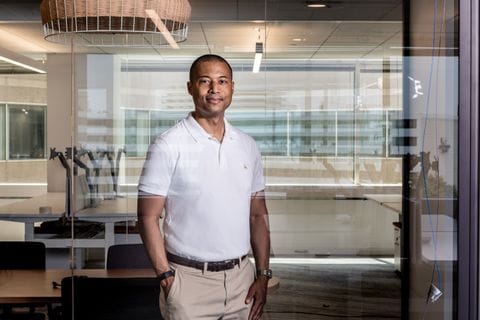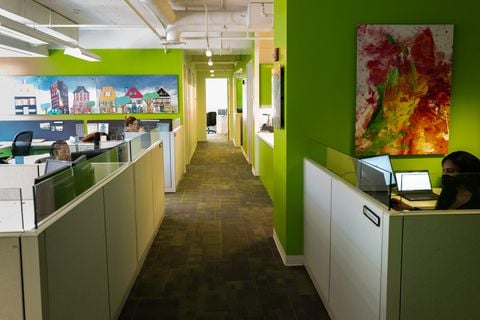For these companies, a year of hardship spurs new beginnings
Alix Guerrier was a graduate student in 2004 at Stanford University when he decided he was done talking to White people about race.
The moment arrived during a class about interpersonal dynamics, where once again, Guerrier found himself explaining why being Black was not an advantage for admissions decisions to his White peers.
This nonconfrontational approach worked for years — until 2020, when, as chief executive of the nonprofit GlobalGiving in Washington, he found himself thrust into the position of dealing with a global pandemic with particularly dire consequences for people of color and the police killing of George Floyd, which changed the conversation about social justice.
“I felt in the spotlight as the leader — the Black leader — of a social mission and mission-driven organization,” he said. “I was aware that there was a need for me to do something or maybe an opportunity for me to do something. But I really felt ill-equipped.”
But after intense soul-searching and a shedding of long-held defense mechanisms, he realized that there was power in taking a proactive position.
“Once I thought of it that way — which is, I’m a learner, the organization is a beginner in this topic, but I’m a beginner also in this role — it proved to be a more productive stance,” he said.
Since then, GlobalGiving, a mostly White organization, has turned an introspective eye on its practices and policies. Leaders have pledged to conduct an implicit bias audit of their programming, including recruiting, onboarding and training programs — but also how the organization distributes funds to its nonprofit partners.
Now, 15 months after sending everyone home, Guerrier is preparing in August to open a new office in Thomas Circle in Northwest Washington with twice the space to accommodate virtual/in-person meetings and social distancing. The new normal will consist of not only the diversity programs but also mental health policies giving the 80 employees extra time off, designated meeting-free days, and the option to work remotely or in the office.
 Alix Guerrier, CEO of GlobalGiving, stands in the nonprofit’s new headquarters after months of working from home. (Maria Luz Bravo for The Washington Post/for The Washington Post)
Alix Guerrier, CEO of GlobalGiving, stands in the nonprofit’s new headquarters after months of working from home. (Maria Luz Bravo for The Washington Post/for The Washington Post) GlobalGiving is among numerous organizations and firms that were transformed, in ways small and large, by the worst year that anyone can remember.
Over the past year a virus forced millions of people to suddenly abandon the office, prompting a proliferation of work-from-home tech tools and remote-work arrangements. Work life and home life clashed like never before. Personal tragedy and prolonged isolation took a sharp toll on peoples’ well-being. And a national reckoning over the murder of Floyd by a Minneapolis police officer prompted many firms to turn a harsh lens on racial bias in their ranks.
The best bosses took each crisis head-on, reshaping policies and rolling out new initiatives to help employees cope.
But now, as vaccines offer a chance to return to the old ways, the working world confronts new questions: What happens next? How many of these changes are permanent? Will things return to the old normal, leaving 2020 as little more than an ugly chapter in America’s collective rearview mirror? Or has our relationship with work been permanently altered?
To get a sense of how the best employers are charting post-pandemic work, The Washington Post brought these questions to its Top Workplaces winners — a list of 200 organizations that received high ratings from their employees in companywide surveys conducted by Energage, a Philadelphia-based workplace intelligence company. Post reporters reviewed survey responses provided by more than 150 companies, and interviewed dozens of employees and managers about their version of The Great Return.
The Post found widely divergent experiences across companies, and from one employee to the next. Many yearn for a return to the old normal and are hoping that the surge of vaccinations will effectively turn back the clock. Some want to keep working from home part or full time. And still others are asking something entirely different from their employers, starting from the realization that the workplace itself is deeply flawed and needs to evolve.
Many are convinced that the office — whatever that means — is forever changed.
“When do we get back to normal? The answer is never,” Guerrier said.
“We’re coming back with a spirit of creativity and flexibility,” he added. “We’re going to continue to examine ourselves and continue to change our norms.”

Global Giving is preparing to open its new headquarters in Thomas Circle in Northwest Washington in August.

The new office will have twice the space to accommodate virtual/in-person meetings and social distancing.

Kristin Wright is seen in the new office. The company is giving workers extra time off, meeting-free days and the option to work remotely. (Photos by Maria Luz Bravo for The Washington Post)
TOP: Global Giving is preparing to open its new headquarters in Thomas Circle in Northwest Washington in August. BOTTOM LEFT: The new office will have twice the space to accommodate virtual/in-person meetings and social distancing. BOTTOM RIGHT: Kristin Wright is seen in the new office. The company is giving workers extra time off, meeting-free days and the option to work remotely. (Photos by Maria Luz Bravo for The Washington Post)
New ways of working
For Tollie Elliott, 2020 was a year of compounding crises — and transformation.
One day in late September, as Elliott sat down with his boss for their weekly lunch at a sandwich shop near the District’s Georgetown neighborhood, the world’s problems seemed to be right at his doorstep.
As chief medical officer overseeing teams of doctors, nurses and psychiatrists at the nonprofit Mary’s Center, his staff was waging an all-out war against a virus that disproportionately affected the primarily Black and Latino communities his organization serves. The organization embraced telemedicine, but not before a third of the staff got covid.
And he found it hard to ignore the political and social crises that had engulfed the nation. An obstetrician-gynecologist by training, Elliott was incensed at reports of forced hysterectomies at an immigration facility in Georgia. And the murder of Floyd forced him to rethink the organization’s role in the community.
“What came out of that was the perspective of Mary’s Center as an anti-trauma organization,” Elliott said. “We are against trauma everywhere and at all times.”
Elliott devoted much of his year to pushing the organization, including its 148 health-care providers and roughly 60,000 patients, to embrace telemedicine. About 60 percent of the organization’s patient interactions now happen through telemedicine, an executive said. And Elliott said he now sees it as an essential component of how Mary’s Center serves its patients, even as in-person meetings become more common.
“At this point, we will not hire someone who will not engage with patients in that format,” Elliott said.
The remote work experience has also expanded horizons for Laurian Eckle, chief executive of a small IT company called Summit2Sea Consulting. Eckle said she once recruited new employees primarily in the Washington area. Summit2Sea has never had a formal corporate office. Its employees reported directly to government client sites clustered around the city.
But the coronavirus forced some government agencies to relax the bureaucratic rules preventing remote work, with the federal government now embracing Microsoft Teams and other communications platforms. Some national security-centric jobs that were once strictly in-person can now be conducted remotely from anywhere.
The 90-person company started holding virtual check-ins more often. And in May, as more members of the workforce have been vaccinated, employees gathered around a firepit in Eckle’s backyard. She flew in out-of-towners on the company’s dime, but it wasn’t a required trip.
“This has opened up the door for us to find talent all across the country,” Eckle said.
 Laurian Eckle, CEO of Summit2Sea Consulting, said the remote work experience has expanded the company’s horizons. (Shuran Huang for The Washington Post)
Laurian Eckle, CEO of Summit2Sea Consulting, said the remote work experience has expanded the company’s horizons. (Shuran Huang for The Washington Post) Jessica Moseley, an Austin-based consultant with Summit2Sea, says the world’s sudden embrace of remote work has actually made her feel more connected to her colleagues. Before the pandemic, Moseley was one of just a few Summit2Sea employees working from a far-flung state. But a third of Summit2Sea’s recent hires in the past year are outside the D.C. area.
Having more remote colleagues has made it easier to feel connected with her colleagues, Moseley said. The water cooler talk now happens online.
The pandemic “has forced companies to test out the remote model, and I think a lot of them are finding that people are just as productive that way,” said Michelle Fox, a systems analyst at Summit2Sea, taking a reporter’s call from her Montana home overlooking the Beartooth Mountains, just outside of Yellowstone National Park.
At Carfax, a Centreville, Va.-based company that provides vehicle history reports for used cars, the all-online way of working gets mixed reviews. Many employees are eager to return to the office, but they are intent on keeping some element of the freedom that comes with working remotely.
“Really, the only thing I miss about the office is my people,” said Yami Lopez, who works on Carfax’s vehicle history reports. Lopez treasures the extra time she has spent with her 11-year-old son — each of them glued to Zoom calls in the same room of their apartment.
“I would like to be able to go in and see everyone, and then come home,” Lopez said.
Lopez said she has actually become more connected to some people, simply due to seeing their faces every day on the Zoom calls. “I feel like we’re more of a team now,” she said.
Tiger Tang, a data scientist at Carfax, said the company’s increasingly lively Slack channels have created a new sort of collective feel.
“It’s making the small talk we used to have at the coffee machine into small talks with everyone,” Tang said. “If I had been chatting in person I wouldn’t be able to send out GIFs, and I would have had to yell to wish everyone a happy Friday,” Tang said, referring to the little animations that have increasingly made their way into workplace conversations.
Several at Carfax said the remote-work experience has allowed them to meet new friends, and forge strong relationships with people they once counted as little more than acquaintances.
“Even with the little GIFies you see a funny side of somebody that you didn’t see before,” Lopez said.
 Summit2Sea team members gather in Eckle’s backyard in Arlington on May 13. (Shuran Huang for The Washington Post)
Summit2Sea team members gather in Eckle’s backyard in Arlington on May 13. (Shuran Huang for The Washington Post) Embracing mental health
Still others have noticed a shift in the way people engage with one another. There’s more openness. Mental health problems seem less like a personal weakness and more like a collective challenge.
And several employees said they have learned to take better care of themselves, in many cases prompted by a burnout-fueled crash in the early months of the pandemic.
Alyssa Romano, a 32-year-old sports publicist with the McLean, Va.-based marketing firm Octagon, remembers one day in late April 2020 when she put her laptop down, took a long walk and thought things over.
For close to two months, her workday had stretched from 5 a.m. to 9 p.m. as her professional basketball clients struggled with canceled games and disrupted seasons. Single and with no children, she had been taking on more work to cover for some colleagues.
 Alyssa Romano, a sports publicist with Octagon, holds a tote bag with the logo for the No Rules Book Club, which she founded with some old college friends as a way to unplug from the stress and burnout she encountered on the job. (Noemie Tshinanga for The Washington Post)
Alyssa Romano, a sports publicist with Octagon, holds a tote bag with the logo for the No Rules Book Club, which she founded with some old college friends as a way to unplug from the stress and burnout she encountered on the job. (Noemie Tshinanga for The Washington Post) “There were no boundaries, and the work never ended,” she said. “Eventually I hit a wall and needed to step back.”
She returned to her Los Angeles-area Airbnb with the realization that she wanted to be defined by more than just her work.
After that, she gradually forced herself to unplug. She started ignoring nonessential emails when they came in late at night. She exercised more. She started No Rules Book Club with some old lacrosse friends from college and they even made a logo for it.
And as her colleagues became more open about their own challenges, she changed the way she thought about mental health. Before, she thought of it in a clinical way — people suffering from acute psychological problems. Now she considers mental health in more of a universal way, as a basic need to take time for oneself.
“It was like a mind-shift,” she said.
She would face an entirely new set of challenges when the Floyd murder thrust her clients into a conversation around racial justice. Octagon’s WNBA clients had been outspoken on racial justice issues for years, she said. And she also works with the Milwaukee Bucks, which was the first NBA team to cancel games amid last summer’s nationwide protests.
Her principal challenge became relating to Black athletes and helping them through the intense pressure that comes with taking a bold public stance.
Referring to a WNBA player she works with, but declined to name for confidentiality reasons, she said: “I wanted to help her and raise her up, but I also had no idea what she was going through.”
She said the racial reckoning added an entirely new dimension to her work.
On issues of racial justice “every team and every player now has a plan in place,” she said, even if the plan is not to engage. “It’s not just a reaction anymore.”

Eva Conforti is seen at marketing firm Octagon’s headquarters in McLean, Va.

Only a quarter of Octagon’s workforce has been in the office to comply with the company’s distancing guidelines.

In the past year, Octagon has had to help Black athletes navigate taking a stance on the racial justice protests. (Photos by Maria Luz Bravo for The Washington Post)
TOP: Eva Conforti is seen at marketing firm Octagon’s headquarters in McLean, Va. BOTTOM LEFT: Only a quarter of Octagon’s workforce has been in the office to comply with the company’s distancing guidelines. BOTTOM RIGHT: In the past year, Octagon has had to help Black athletes navigate taking a stance on the racial justice protests. (Photos by Maria Luz Bravo for The Washington Post)
Coming back changed
A year after the outcry over racial injustice shook the nation, the return to the office will test the staying power of the public statements, private conversations and the various initiatives implemented in the aftermath of Floyd’s killing.
For many, the reckoning happened at home, over Zoom, mostly alone. But now, employees are emerging from remote work thinking about how historical inequities and past policies have shaped the workplace. Many have said returning to work feels like arriving at the doorstep of real change.
“I think if any change is going to happen, it has to be now,” said Deniece Peterson, 47, director of federal market analysis at Deltek, a government contracting firm in Herndon, Va. “We’ve had opportunities in the past, but this one feels a little different.”
Although Deltek was already rethinking its hiring practices and installed a diversity and inclusion director in 2019, Peterson said this moment forced employees across Deltek to confront the emotional trauma experienced by people of color.
“It was like, wow, it’s not conceptual anymore,” said Peterson. “This is a person in front of me who is emotionally traumatized and trying to work through it.”
 Good360 in Alexandria helps nonprofits distribute technology to communities in need. (Shuran Huang for The Washington Post)
Good360 in Alexandria helps nonprofits distribute technology to communities in need. (Shuran Huang for The Washington Post) Peterson participates in Deltek’s Diversity Council and started Black Voices, an employee resource group that serves as a place for Black employees to come together across the company to share stories, support one another and drive initiatives across the company.
Peterson’s passion for social justice is palpable, but she also recognizes that she alone cannot undo systemic and deeply entrenched inequities. “Racism is not a problem that people that look like me can solve,” she said. “It’s a problem that won’t be fixed until the White community wants to fix it and listens to the problems of the underrepresented minorities.”
Her mission, she said, is to make Deltek an actively anti-racist workplace. “I’m on a crusade. I’m in a great environment for it. And people seem to listen to me. So, I’m going to leverage that currency as much as I can.”
For others, the summer’s reckoning hit even closer to home. Last June, Lashowna Dukes, a business analyst at the nonprofit Good360 in Alexandria, Va., was sitting on the floor of her new and unfurnished apartment scrolling through social media, feeling restless and low on hope. Covid had delayed the delivery of her furniture.
It was nearing Juneteenth, an annual holiday that has come to symbolize the end of slavery in the United States — a time when Dukes would normally volunteer in her community. But in 2020, she was alone. It was too dangerous for her to go home to St. Paul, her family told her. Minneapolis was burning.
“You hear these things on the news about what’s happening, but then you have your family and your friends there and it’s like they can’t get diapers because someone from the outside of the community came in and destroyed it,” she said.
In the absence of her community, Dukes said her employer became her support system — it offered her a place to be vulnerable and talk about what was happening in her hometown. “Folks that I did not think cared allowed that space to share stories,” she said.
But Good360 also showed support with action. The organization, which works with nonprofits to distribute products to communities in need, pivoted and started outreach in Minnesota, sending needed goods like KN95 masks, body wash, shampoos, wipes and toys into neighborhoods destabilized by unrest.
The organization is also in the early stages of starting a diversity and inclusion program and is reviewing its hiring and promotion practices.
Last summer also changed the nature of Dukes’s social media feed. Post after post became a call for action: Support Black business. Support Black lives.
But everything felt scattered across social media. “There was data from everywhere. There were numbers from everywhere,” she said. “I was like, what do I do?”
She decided to map it. Using Google Maps, Dukes created a tool to show where Black businesses existed in communities across the country. To date, the map showcases 331 businesses and has garnered more than 26,500 views.
“I think it was a way for people to stay connected, and to feel like they had a part in helping.. . . when other folks felt helpless,” she said.
The Great Return feels like an inflection point for organizations and employees alike. But in many cases the increasing demand for change is being driven from the bottom up, not the top down.
“Employees are not going to allow companies to just check the box anymore,” said Lynn Orosco, diversity, equity and inclusion lead at Eagle Hill Consulting in Arlington, Va. “There’s going to be accountability. They want transparency and authenticity. . . . and organizations need to show they’re doing the work.”
But how employees will return to this work — and the workplace — remains an open question. Some express optimism, others, apprehension. But most think the events of the past year, made visible by both the pandemic and the racial reckoning, cannot go unacknowledged in the office.
“I don’t think any of us know how we’re going to show up,” said Orosco. “The conversation a year from now about diversity, equity and inclusion is going to be so different. And that’s going to be part of the story — is how did we go back?”
One thing is certain, though, she said: “We’re all coming back changed.”
 Lashowna Dukes, a business analyst at Good360, said her employer became her support system in the past year, offering her a place to be vulnerable and talk about what was happening. “Folks that I did not think cared allowed that space to share stories,” she said. (Shuran Huang for The Washington Post)
Lashowna Dukes, a business analyst at Good360, said her employer became her support system in the past year, offering her a place to be vulnerable and talk about what was happening. “Folks that I did not think cared allowed that space to share stories,” she said. (Shuran Huang for The Washington Post) Design by Clare Ramirez. Photo editing by Monique Woo. Copy editing by Kathleen Silvassy.






